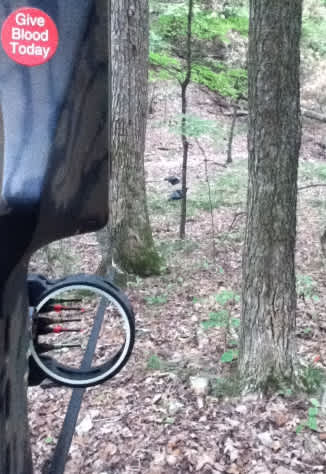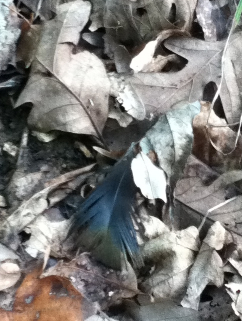Bowhunting in the Turkey Woods
In Search of Whitetails 09.17.12

The first streaks of color painted the eastern sky, and there was movement in the woods. Near-silent shadows crept along narrow trails, through stands of timber and over ridge-tops, all with murder in their hearts. They climbed into tree stands or settled into blinds on the ground. Everything was silent again. It was half an hour before sunrise, and the opening day of bowhunting season in Missouri.
Like thousands of hunters, I was up well before dawn, fully camouflaged, and sneaking into the woods with bow in hand. Unlike most of them, I was after a different prey: the eastern turkey. The area I’d chosen to hunt was a patch of open ground between two wooded ridges, bounded on one side by a fallen tree. About a year ago, I’d watched a gobbler strutting for his pack of hens here for hours. Plus, my Labor Day scouting expedition had revealed signs of a good flock of turkeys: wing feathers, chest feathers, and a bounty of acorns.
I snuck down a dry creek to reach the low point between two ridges. Nearing my hunting spot, I jumped a turkey from its roost 25-30 feet overhead. Then another, and another. Looks like I stumbled right into the roosting area. The birds had all flown off in a single direction, and glided south into a field, landing perhaps 150 yards away. Quickly, quietly, I set up my decoys (2 hens and a jake) and set up.
Calling All Turkeys
My go-to turkey call is the aptly named Knight & Hale Tom Coffin, a box-shaped call that’s useful for bowhunting because you can use it one-handed. I began with a couple of yelps, alternating with occasional soft clucks. From a ridge to my right (and slightly behind me), a tom gobbled in response. It was a thrill to hear this, and to know that my quarry hadn’t left the area entirely.
Unfortunately, though he gobbled a few other times, I couldn’t entice this gobbler over to my side of the ridge. After a couple of hours I stalk-hunted quietly up over the ridge and explored the area a bit, looking for game and sign as I hadn’t scouted this part of the woods.
When Turkeys See You First
I came back to my setup spot, collected my decoys, and stuffed them into my backpack (an important safety step on public land). Of course, it was the moment I started climbing the ridge, headed home, that I spotted a flicker of movement to my right. Perhaps 75 yards distant, I saw a turkey run up the ridge from which I’d come. Then another, and another, five in total. All of them watching me and running away quietly. They’d been hidden in brush on the other wide of the fallen tree. Well within hearing distance of (and probably able to see) my decoys!
I froze, watching and counting the birds, weighing pursuit against the promise of a hot breakfast. When the turkey sees me first, I’m unsure of how to react. I decided to freeze and minimize the apparent threat as much as possible, trying to estimate their direction. The alternative would be to slip after them, to get a much better fix on their direction of travel. I wish I had tried this, because I didn’t see them again.

Challenges of Bowhunting Turkeys
Turkey hunting with a bow is a difficult pursuit. We’re up against an animal with superior vision and hearing, extreme wariness, and that’s well-equipped (through running or flight) to get away from us. Getting close enough to warrant a shot is the first major challenge. The second is making such a shot. Turkeys offer a much smaller target than a deer, and are lower to the ground. Their excellent sight and hearing make it very hard to draw and aim without being detected.
Still, it can be done.
I know it’s a good-sized flock of mature birds with at least one gobbler. There are wing and breast feathers all over the area. You can determine the sex of a turkey from a breast feather’s tip color: brown for hens, black for gobblers. I saw both, including the one to the right.So my first hunt was a bust. On the plus side, I’ve learned more about the patterns of this flock of birds, and scouted their territory more thoroughly. My next opportunity to hunt this ground won’t be for another 2 weeks, which leaves me plenty of time to plan. I’ve discovered their roosting area, and where they spend much of the morning.
Now it’s just a matter of setting the perfect ambush.
This post first appeared on In Search of Whitetails and is republished with permission.

